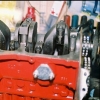My master cylinder does indeed have a yellow tag. I assume that's a global standard then and no difference between your yellows and ours
To be clear, I'm referring to the GMC227
http://www.minispare...|Back to search
To be additionally clear, I'm not at all saying it's a rubbish cylinder, it's not. It's just doesn't meet the various standards in all markets.
Probably straying from the topic here, but the concept as I understand it of Tandem Brakes in general, is so that should a hydraulic failure occur in one circuit, the other will still work, just with a lower pedal and reduced braking performance. I've found with both the GMC227 and the GMC167 that this is not the case, a failure in either circuit will result in the pedal hitting the floor long before any pressure is made in the healthy circuit.




















